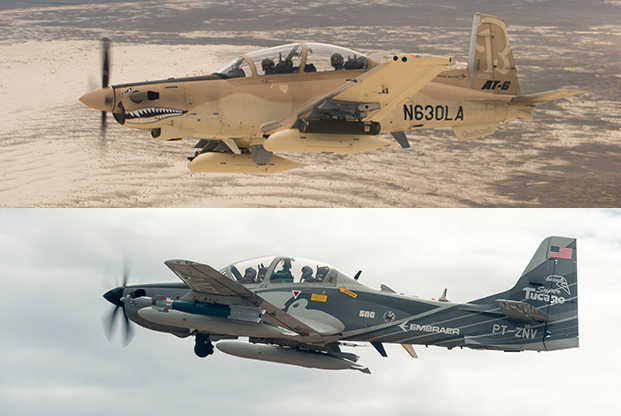
USAF already has narrowed the field for a new light attack aircraft to two competitors: Textron Aviation, which is offering the AT-6 (shown at top), and Sierra Nevada and Embraer, offering the A-29 Super Tucano (shown at bottom). Air Force photos. ?
SAN ANTONIO—The Air Force has two disparate options for how it could base and use a new light attack aircraft, depending on how many it chooses to buy at the end of the light attack experiment, the head of Air Combat Command planning said Friday.
The service is preparing to release its final request for proposals on the light attack experiment, with plans for an initial award in the fourth quarter of 2019. USAF already has narrowed the field to two competitors: Textron Aviation, which is offering the AT-6, and Sierra Nevada and Embraer, offering the A-29 Super Tucano. Maj. Gen. Scott Pleus, the director of plans, programs, and requirements for ACC, said Friday that the Air Force’s budget release early next year will lay out its planned buy, which will then dictate how the service will assign and base the aircraft.
If the service plans to buy fewer than about 100 of the aircraft, ACC will have “very little play” in the program at all, Pleus said Friday at the Military Flight Training USA 2018 conference here. With a fleet that small, it would be an Air Force Special Operations Command asset to be used for low-intensity combat situations under US Special Operations Command.
However, if the Air Force goes through with a large buy of, for example, 300 aircraft or more, ACC would then lay out a large basing concept for the aircraft. This would likely include a “couple” continental US bases, as well as a “forward presence” in both US Air Forces in Europe and Pacific Air Forces, Pleus said.
Because neither of the options being considered is air refuelable, the Air Force would need to take the aircraft’s wings off, send them over the oceans, and then rebuild them. Once overseas, the aircraft would stay there, and airmen would rotate through the assignments in a system similar to the theater security package model though only people would deploy, he said.
The service held two rounds of experiments to test the aircraft, and originally planned to send finalists to US Central Command for real-world operations but that was nixed because USAF officials said they had gathered enough information.